1. Thanks for replying
The problem with that strategy is, that they already dominate the AI GPU Market with Huawei being the only real alternative. Other domestic companies like Tencent are reluctant to switch to Huawei because they dont want to be reliant on them and unless someone like Moores Thread or Biren develops an alternative, they are unlikely to switch anyway. Other than that, it takes away the competitive advantage that US Companies have over Chinese ones and might therefore accelerate Chinas AI development (,which the US thinks it bad). It would make sense if Biren or Moores Thread were making 7nm AI Chips but they dont so the US wouldnt really gain anything from it.The new (proposed) strategy of allowing AI GPUs like Nvidia H100s and A100s to be sold enables China to be addicted to Western software ecosystems (i.e., CUDA) and dominate domestic alternatives.
That is exactly the reason why I dont see Huawei being allowed to fab at TSMC, since it would make them more competitive and therefore takes away marketshare from other companies like Samsung or Apple, meaning less profits for them and therefore less R&D (not to mention that TSMC is a Taiwanese company and not an American so the US would never allow it anyway). As you correctly pointed out, Huawei would also only ever a temporary customer and would switch back to SMIC as soon as possible and therefore bringing no real long-term advantage (unless Huawei develops "dementia" or a "forget und forgive" attitiude, but i seriously doubt it). Huawei is currently also capacity limited and I think the US wants to keep it that way for as long as possible.Huawei isn't dumb, it will still cultivate it's domestic supply chain, but I'm sure Huawei would be interest in some chips from TSMC for global versions of Mate series. For high-end chips, Huawei can dual source SMIC and TSMC for China-only versions and Global versions of Mate series, respectively. It would allow Huawei to be competitive in overseas. Later revert to single sole source from SMIC when 3nm EUV is scaled.



